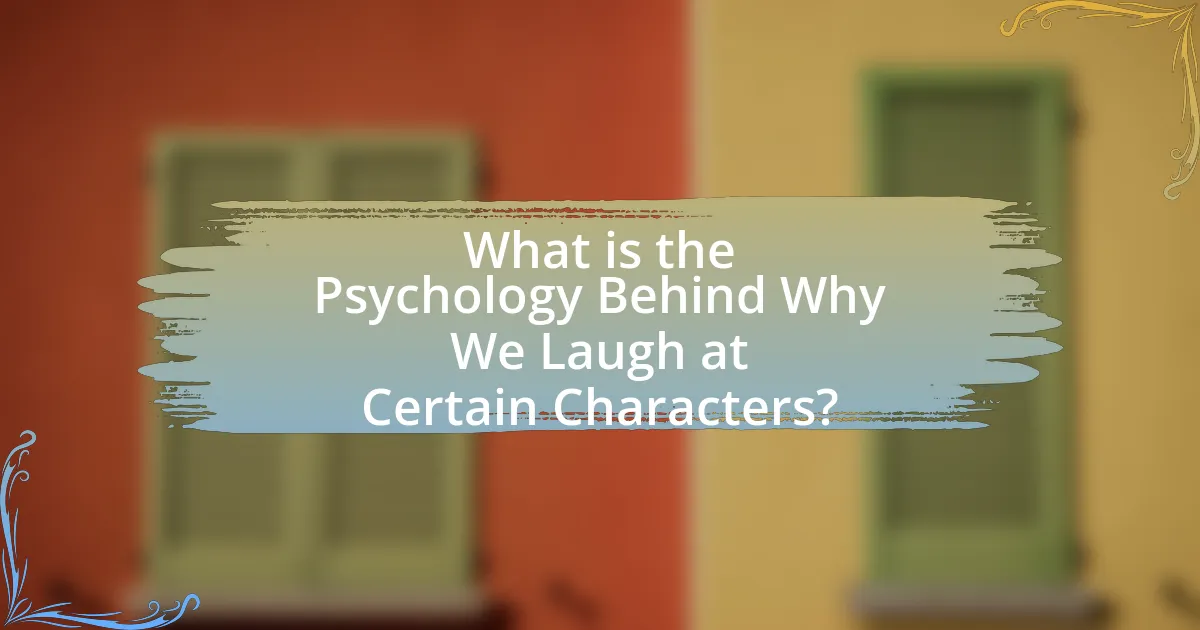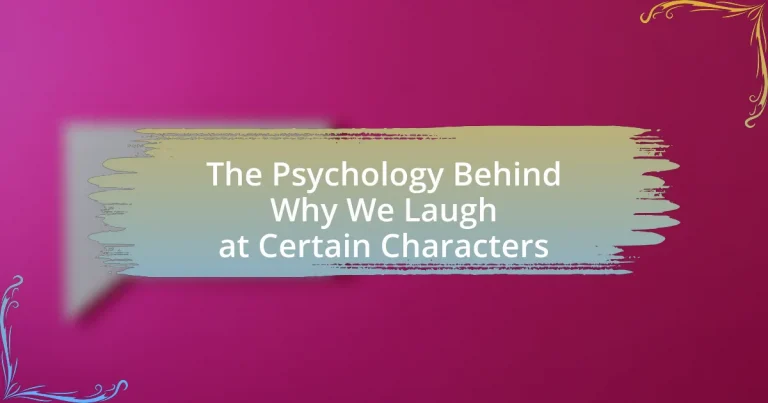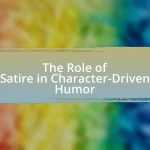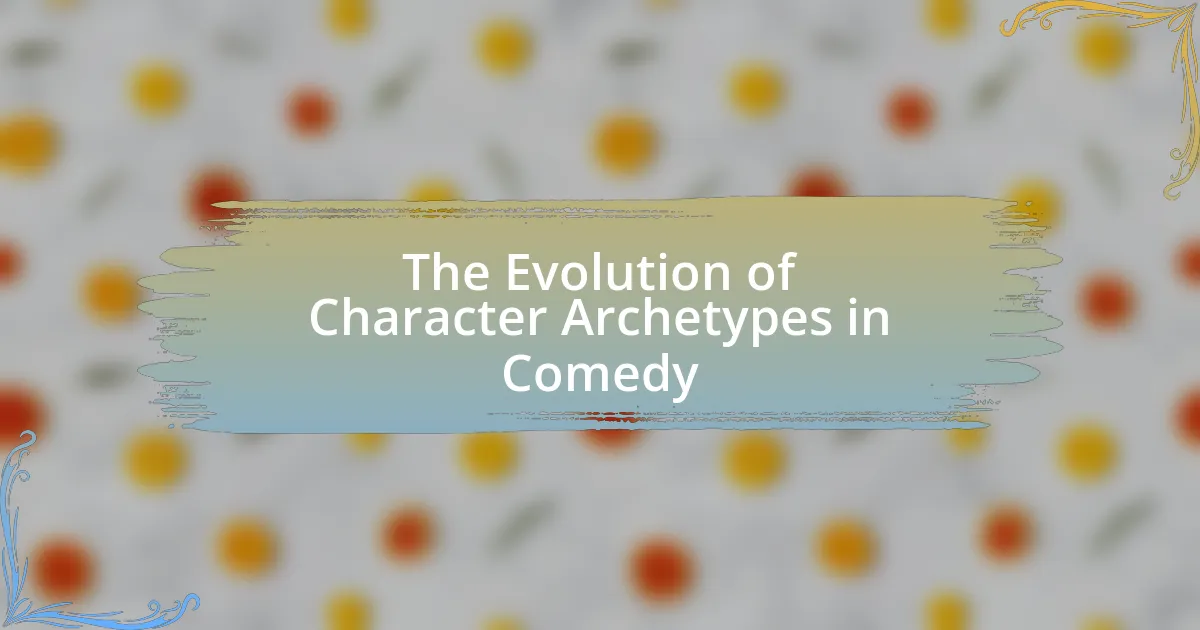The article explores the psychology behind why we laugh at certain characters, focusing on key theories such as incongruity and relief theory. It examines how character traits, including exaggeration, relatability, and vulnerability, influence humor and audience perception. Additionally, the article discusses the role of character archetypes in comedy, the impact of context and cultural factors on humor, and psychological theories that explain laughter. Practical tips for writers on enhancing character humor and engaging audiences are also provided, emphasizing the importance of relatable traits and effective timing in storytelling.

What is the Psychology Behind Why We Laugh at Certain Characters?
The psychology behind why we laugh at certain characters is rooted in the concepts of incongruity and relief theory. Incongruity theory suggests that humor arises when there is a discrepancy between what is expected and what actually occurs, leading to surprise and amusement. For example, a character who behaves in an exaggerated or absurd manner can trigger laughter because their actions defy social norms or logical expectations. Relief theory posits that laughter serves as a release of psychological tension, allowing individuals to cope with stress or taboo subjects presented through characters. Research by Martin et al. (2003) in “The Psychology of Humor: An Integrative Approach” supports these theories, indicating that humor often involves a cognitive process of recognizing incongruities and a physiological response to the relief of tension.
How does humor relate to character traits?
Humor is closely related to character traits, as specific traits can influence the type and effectiveness of humor a character exhibits. For instance, characters who are extroverted often display more playful and spontaneous humor, while those who are neurotic may use humor as a coping mechanism, leading to self-deprecating jokes. Research indicates that humor styles are significantly correlated with personality traits; for example, a study published in the Journal of Personality and Social Psychology found that individuals with high levels of openness to experience tend to appreciate and engage in more complex forms of humor, such as satire and irony. This relationship illustrates how character traits shape not only the humor a character uses but also how audiences perceive and respond to that humor.
What specific traits make characters more humorous?
Characters are more humorous when they exhibit traits such as exaggeration, incongruity, and relatability. Exaggeration amplifies characteristics or situations to absurd levels, making them funny; for example, a character who is overly clumsy can create comedic scenarios. Incongruity arises when there is a mismatch between expectations and reality, such as a serious character in a silly situation, which often leads to laughter. Relatability allows audiences to connect with characters on a personal level, making their humorous experiences resonate more deeply. Research by Martin et al. (2003) in “The Psychology of Humor: An Integrative Approach” supports that these traits enhance comedic effect by engaging the audience’s cognitive and emotional responses.
How do these traits influence audience perception?
Traits such as relatability, exaggeration, and vulnerability significantly influence audience perception by shaping how viewers connect with characters. Relatable traits allow audiences to see themselves in characters, fostering empathy and engagement. Exaggerated traits often enhance comedic effect, making characters memorable and entertaining, as seen in classic sitcoms where over-the-top personalities drive humor. Vulnerability can evoke sympathy, prompting audiences to root for characters despite their flaws. Research indicates that characters who exhibit a mix of these traits are more likely to elicit laughter, as they resonate with viewers’ experiences and emotions, thus reinforcing the connection between character traits and audience perception.
Why do we find certain character archetypes funny?
Certain character archetypes are found funny due to their exaggerated traits and the incongruity they present in familiar situations. These archetypes, such as the fool or the trickster, often embody characteristics that are socially or culturally recognized as humorous, leading to a cognitive dissonance when their actions contrast with expected norms. Research indicates that humor arises from the violation of social expectations, as outlined in the Incongruity Theory of Humor, which posits that humor is generated when there is a discrepancy between what is anticipated and what actually occurs. For example, the bumbling fool archetype elicits laughter because their incompetence disrupts the expected flow of events, creating a comedic effect.
What are common character archetypes in comedy?
Common character archetypes in comedy include the fool, the straight man, the wisecracker, the eccentric, and the underdog. The fool often provides humor through ignorance or naivety, while the straight man serves as a foil, reacting to the absurdity around them. The wisecracker delivers witty remarks, adding a layer of sarcasm, whereas the eccentric character brings unpredictability and quirkiness to the narrative. The underdog archetype resonates with audiences due to their relatable struggles and triumphs against adversity. These archetypes are prevalent in comedic works because they create relatable situations and evoke laughter through their interactions and conflicts.
How do these archetypes resonate with audiences?
Archetypes resonate with audiences by embodying universal traits and experiences that evoke familiarity and emotional connection. For instance, the “Hero” archetype often represents courage and resilience, allowing audiences to see their own struggles reflected in the character’s journey. This connection is supported by psychological theories, such as Carl Jung’s concept of archetypes, which suggests that these character types tap into the collective unconscious, making them relatable across different cultures and contexts. Additionally, studies show that characters who align with specific archetypes can elicit stronger emotional responses, enhancing audience engagement and laughter, as seen in comedic films where the “Fool” archetype often provides humor through their naïveté and misadventures.
What role does context play in our laughter at characters?
Context significantly influences our laughter at characters by shaping our understanding of their actions and the situations they encounter. The situational context, including cultural norms, social dynamics, and narrative circumstances, determines whether a character’s behavior is perceived as humorous or inappropriate. For example, a character’s clumsiness may elicit laughter in a light-hearted setting but could be viewed negatively in a serious context. Research indicates that humor often relies on incongruity, where the unexpectedness of a character’s actions in a given context can trigger laughter. This is supported by studies in psychology, such as those by Martin (2007), which highlight how contextual cues affect humor appreciation. Thus, context serves as a critical framework that guides our emotional responses to characters, ultimately influencing our laughter.
How does situational comedy enhance character humor?
Situational comedy enhances character humor by placing characters in relatable, often absurd scenarios that highlight their quirks and flaws. This genre relies on the context of the situation to amplify comedic elements, allowing audiences to connect with characters on a personal level. For example, in shows like “Friends,” the characters’ distinct personalities are exaggerated through their interactions in everyday situations, making their humor more impactful. Research indicates that humor often arises from incongruity, where the unexpected nature of a situation contrasts with the characters’ established traits, leading to laughter. Thus, situational comedy effectively utilizes context to deepen the audience’s understanding and appreciation of character humor.
What examples illustrate context-driven humor?
Context-driven humor is exemplified by situational comedy in television shows like “The Office,” where characters’ reactions and interactions are rooted in their workplace environment, creating humor that resonates with viewers familiar with office dynamics. Another example is the character of Michael Scott, whose lack of social awareness leads to awkward yet humorous situations that reflect real-life workplace scenarios. Additionally, stand-up comedians often use context-driven humor by referencing current events or cultural phenomena, making their jokes relatable to the audience’s shared experiences. This type of humor relies heavily on the specific context in which it is presented, enhancing its effectiveness and relatability.
How do cultural factors influence our laughter at characters?
Cultural factors significantly influence our laughter at characters by shaping the norms, values, and humor styles that dictate what is considered funny within a specific society. For instance, in collectivist cultures, humor often revolves around group dynamics and shared experiences, leading to laughter that reinforces social bonds. Conversely, in individualistic cultures, humor may focus on personal achievement or self-deprecation, eliciting laughter that highlights individual traits or quirks. Research indicates that cultural context can determine the appropriateness of humor; for example, a study by Matsumoto and Hwang (2013) found that humor appreciation varies widely across cultures, with certain jokes resonating more in specific cultural settings due to differing social expectations and taboos. Thus, cultural factors play a crucial role in shaping our responses to comedic characters, influencing both the content of humor and the audience’s reception.
What cultural differences exist in humor perception?
Cultural differences in humor perception significantly influence what individuals find funny. For instance, Western cultures often favor individualistic humor that emphasizes personal experiences and self-deprecation, while collectivist cultures, such as those in East Asia, may prefer humor that reinforces social harmony and group cohesion. Research by Robert R. Provine in “Laughter: A Scientific Investigation” highlights that laughter varies across cultures, with some cultures using humor as a coping mechanism in stressful situations, while others may view it as inappropriate in serious contexts. This indicates that cultural norms and values shape humor appreciation, leading to diverse interpretations and responses to comedic content.
How do societal norms shape character humor?
Societal norms shape character humor by establishing the boundaries of acceptable behavior and defining what is considered funny within a cultural context. These norms influence the types of jokes and comedic situations that resonate with audiences, as humor often relies on shared values and experiences. For example, a character who subverts societal expectations, such as a rebellious teenager challenging authority, may elicit laughter because they reflect a common cultural tension. Research indicates that humor is often a reflection of social dynamics; a study published in the Journal of Personality and Social Psychology found that humor can reinforce group identity and cohesion by highlighting shared beliefs and values. Thus, societal norms not only dictate what is humorous but also shape the characters that embody these comedic elements.
What psychological theories explain our laughter at characters?
Psychological theories explaining our laughter at characters include the incongruity theory, superiority theory, and relief theory. The incongruity theory posits that humor arises when there is a discrepancy between what is expected and what actually occurs, leading to laughter as a response to the surprise or absurdity of a character’s actions. For example, a character’s unexpected behavior in a serious situation can trigger laughter due to this incongruity.
The superiority theory suggests that laughter stems from a feeling of superiority over the characters, often when they experience misfortune or embarrassment, allowing the audience to feel a sense of relief or joy in their own situation. This is evident in slapstick comedy, where characters face humorous mishaps.
Relief theory, proposed by Sigmund Freud, indicates that laughter serves as a release of psychological tension, allowing individuals to express repressed emotions. Characters that evoke this tension, such as those in comedic scenarios, can lead to laughter as a form of emotional release.
These theories collectively illustrate the complex psychological mechanisms behind why audiences find humor in characters, supported by various comedic examples and psychological frameworks.
How does the incongruity theory apply to character humor?
The incongruity theory applies to character humor by suggesting that humor arises when there is a mismatch between expectations and reality regarding a character’s behavior or traits. This theory posits that when a character acts in an unexpected or absurd manner, it creates a cognitive dissonance that prompts laughter as a response to the surprise. For example, a serious character suddenly engaging in silly antics can evoke humor because it contrasts sharply with the audience’s preconceived notions of that character’s personality. Research supports this, indicating that humor often stems from the violation of social norms or logical expectations, which is a core principle of the incongruity theory.
What role does relief theory play in our reactions?
Relief theory posits that laughter serves as a release of psychological tension, playing a crucial role in our reactions to humor. This theory suggests that when individuals experience stress or anxiety, humor provides a mechanism to alleviate these feelings, allowing for emotional relief. For instance, Sigmund Freud, who significantly contributed to this theory, argued that laughter acts as a safety valve, releasing pent-up emotions and facilitating a return to emotional equilibrium. Empirical studies have shown that laughter can lower cortisol levels, a hormone associated with stress, thereby reinforcing the idea that relief theory is integral to understanding why we laugh at certain characters, particularly those that embody absurdity or misfortune.
How can understanding character humor improve storytelling?
Understanding character humor can significantly enhance storytelling by creating relatable and engaging narratives. When writers grasp the nuances of humor associated with their characters, they can develop more authentic interactions and situations that resonate with audiences. For instance, research indicates that humor fosters emotional connections, making characters more memorable and their journeys more impactful. A study published in the Journal of Personality and Social Psychology found that humor can increase likability and perceived competence, which are crucial for character development. By effectively incorporating humor, storytellers can not only entertain but also deepen the audience’s investment in the characters and their arcs.
What techniques can writers use to create humorous characters?
Writers can create humorous characters by employing techniques such as exaggeration, incongruity, and clever dialogue. Exaggeration amplifies traits or situations to absurd levels, making characters more comical; for instance, a character who is overly clumsy can lead to humorous scenarios. Incongruity involves placing characters in unexpected situations or giving them contradictory traits, which can create humor through surprise. Clever dialogue, filled with puns or witty banter, can also enhance a character’s comedic appeal, as seen in works like “The Office,” where quick exchanges often lead to laughter. These techniques are effective because they tap into the psychological mechanisms of surprise and relatability, which are fundamental to humor.
How can character humor enhance audience engagement?
Character humor enhances audience engagement by creating relatable and memorable experiences that foster emotional connections. When characters exhibit humor, they often reflect human traits and vulnerabilities, allowing audiences to see themselves in those characters. This relatability increases viewer investment in the narrative, as humor can break down barriers and make the content more accessible. Research indicates that humor activates the brain’s reward system, releasing dopamine, which enhances enjoyment and retention of information. For instance, a study published in the journal “Cognitive Processing” found that humor can significantly improve recall and engagement levels in audiences, demonstrating its effectiveness in capturing attention and maintaining interest.
What practical tips can enhance character humor in writing?
To enhance character humor in writing, authors should focus on developing relatable traits, employing timing effectively, and utilizing exaggeration. Relatable traits allow readers to connect with characters, making their humorous moments more impactful. Effective timing, such as delivering punchlines at the right moment, can amplify the humor, as seen in comedic timing studies that show well-timed jokes are perceived as funnier. Exaggeration, when characters display extreme reactions or traits, creates absurdity that often leads to laughter, supported by the incongruity theory of humor, which suggests that humor arises from the juxtaposition of unexpected elements.





